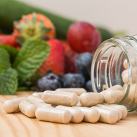Blog
10 Reasons Breast Milk Is So Special
It is well-known that no company in the world will ever be able to “imitate” breast milk. And that’s because breastfeeding is irreplaceable! It’s impossible to make processed cow’s milk for babies that looks even the slightest bit like breast milk. One of the parameters that determine the superiority of breast milk is its uniqueness in every moment.
Breast milk has a wonderful way of personalizing for each child and its composition changes, depending on the occasion, always to the maximum possible benefit for the baby’s health. Processed cow’s milk for babies remains the same for every child, every day for six or twelve months. Cow’s milk is a monotonous fast food, compared to the unsurpassed variety of the mother. In particular, breast milk is completely different in composition and properties:
1. From child to child.
Every mom produces a different breast milk and the variety of compositions from woman to woman is great. Scientists have long known the huge variety from woman to woman in the percentages of fats, vitamins, trace elements, etc. This differentiation serves and “suits” the needs of the specific child.
2. From child to child of the same mother.
The milk of the first-born is different from that of the second-born. Differences in the composition of breast milk have been detected even in twins, depending on the needs of each!
3. Depending on the sex of the child.
It has been found that mothers who have a baby boy produce milk with 25% more energy compared to those who have a baby girl, apparently to meet greater needs!
4. Depending on the age of the baby.
Premature breast milk has extra protein, calories, fat, minerals and trace elements, as well as defense and growth factors, to support prematurity. Colostrum, the milk of the first days, is essentially a powerful vaccine full of cells, antibodies, hormones and enzymes for the fragile baby that is born. After the first six months of life, breast milk becomes less in quantity, but it is more fulfilling – at least by 50%, containing fat that can sometimes reach 28%! Long-term breastfeeding milk provides concentrated energy, a stable amount of antibodies, more casein to create a feeling of satiety in the child, large amounts of vitamins such as vitamin C and B12, as well as valuable growth factors for the brain, such as cholesterol and serotonin that are missing or found in small amounts in commercial milks.
5. Depending on the mother’s eating habits.
The breastfed baby enjoys a variety in the taste of his food, depending on the food that the mother consumed each time. Simply put, breast milk tastes like garlic, if mom ate garlic or leeks, if mom ate leeks! The baby is exposed to the flavors of different foods that pass into breast milk and can slowly become more accustomed to solid foods when, at six months of age, it is time to try it. Contrary to popular belief, breastfeeding is a necessary supplement when starting solid foods, it does not replace baby creams and should not be replaced by cow’s milk. Breastfed babies eat food from the family table and tend not to “stick” to baby creams and ground foods.
6. Depending on the time of day.
Breast milk tends to have more volume in the morning, more lactose and water. As the day progresses towards the evening, the milk decreases in quantity, but also accumulates more fat.
At night, breast milk shows significant amounts of melatonin, a hormone of the body that brings sleep! It also contains significant amounts of natural opioids that soothe the baby.
7. From breast to breast of the same mother.
Almost all midwives find a difference in milk production between the right and left breast, with the right usually producing – but not always – more. Another peculiarity that increases the variety in the normal baby diet! A one-year-old baby has fun choosing the breast he wants each time and often going from one to another!
8. During the same meal.
Once the baby grabs the nipple and starts eating, the mother’s milk is watery and sweet. As his meal progresses the last puffs become filling, full of fat!
9. Depending on the time of year.
In summer, in order to cope with the heat, the baby breastfeeds its mother more often. In this way it gets more than the first milk, at the beginning of the meal, which, as we said before, is more watery. In winter, on the other hand, his breast meals tend to be longer and thinner, with more fat and less water.
10. When the baby has a cold.
Whenever a child gets an infection, exposure to that virus or germ is also present for the mother because she lives in the same environment. The mother fights the infection better, shows little or no symptoms, quickly makes special antibodies and defense factors, which reach the baby through her milk. Every time the baby gets sick, breast milk responds with changes in its composition and is filled with protection.
All of the above are ten reasons why no company in the world will ever be able to “imitate” human milk. The truth is that there is not one breast milk but thousands, millions even. The concept of standard human milk is non-existent. Trying to produce something that looks like the average of millions of different things is futile and misleading. Each specific mother is in constant chemical contact with her specific baby, which dynamically determines the respective composition of the milk that will be offered to the baby. Breast milk is a dynamic, living liquid, not dead and static, such as chemical soup – a patchwork of processed infant milk.
Every time you put your baby to the breast, remember you are doing your best for the specific moment, time of day, for the specific needs that your child currently has.

 Ελληνικά
Ελληνικά








































